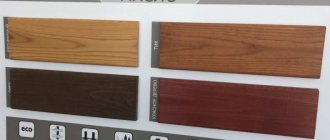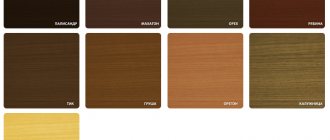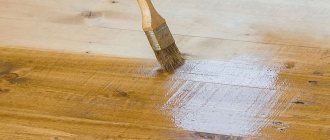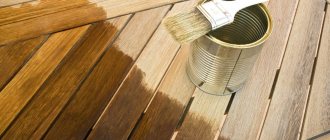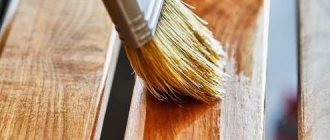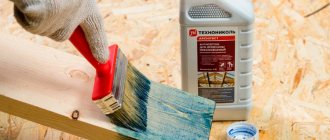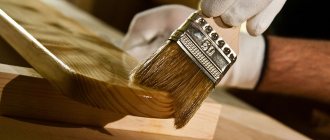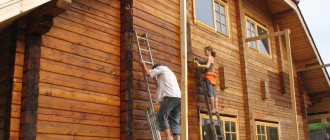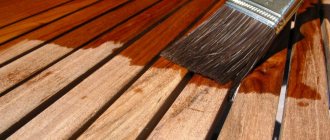Painting wood is an enjoyable and fairly simple task that even beginners can tackle. It's worse when choosing the right product. Which wood paint will work and protect the surface effectively? It's easy to get lost in the maze of names, terms and definitions.
Wood is an elegant material with a very wide range of uses. Due to its properties, competitive strength and resistance to a variety of factors, as well as undeniable aesthetic values, it is often used in interior decoration, construction, as the top layer of a facade or terrace or for the manufacture of small garden architecture elements and furniture.
Therefore, it is not afraid of “threats” arising from indoor use or exposure to adverse weather conditions. It is important not to skip the decisive step: protecting wooden surfaces. Without this, the wood will begin to deteriorate - you will notice fading and wear of the natural shade, as well as further scratches and cracks, which will soon turn into more and more serious damage. One wood protection method worth trying is paint. Which wood paint is best? What should you remember when purchasing?
How to choose paint for wood
To preserve the appearance of wood, you need to use high-quality paint. If you neglect this rule, the tree will be susceptible to fungus.
Pay attention to the following criteria:
- The paint should be uniform and not liquid.
- The content of natural ingredients will be a big plus when choosing paint. Since there will be no strong odor when painting wood.
- To prevent the possibility of fire, wood swelling or burning, the material must be resistant to these processes.
- For your convenience, take quick-drying paint, this will reduce your work time.
- High-quality paint is not subject to mechanical stress. Scratches and cracks will not be visible on it.
When purchasing paint, consumers focus on its appearance and composition.
Criterias of choice
Making the right choice is quite difficult, given the rich assortment of modern supermarkets.
Advice! Don't rush to go to the store. First, study all the important points, paying attention not only to the aesthetic side, but also to the practical one.
Acrylic paints are divided into 2 main categories:
- interior (for interior work);
- façade (for exterior).
The drying process of acrylic paint
Compositions for exterior use differ from interior ones in that they are more resistant to sunlight and various atmospheric influences. Typically, the façade is updated every 3–4 years. Therefore, you should not buy super expensive exterior paint with a long service life.
Read more about this in the material on façade paints for wood.
If painted surfaces are not supposed to be washed regularly with a brush or sponge, you should not choose compounds with a high abrasion rate. This will save you some money. If painting is done in a nursery or bedroom, give preference to hypoallergenic paints of a suitable color.
Criteria for choosing compositions for painting wood:
- Read the ingredients carefully. If it is long and unclear, refuse to purchase. The classic composition of acrylic paint is a filler (base), a binder (connects the paint components to each other, as well as to the surface), and a coloring pigment.
- Choose a product from a reputable manufacturer. If the inscription on the jar does not tell you anything, and the seller’s stories are not convincing, and he cannot show the certificate, refuse to buy.
- Check with the seller what properties the selected sample has (maximum protection against moisture and mold, rodents and insects).
- Estimate the paint consumption per 1 m2.
- Assess the performance capabilities of the future coating.
- Check the cost and calculate the financial costs of painting work.
Types of paints for wood
Before purchasing, you need to understand what kind of work you are taking the material for. The paint can be used for interior or exterior decoration, for processing wooden furniture.
Application area
Acrylic-based paints have a wide range of applications. They are mainly used for processing ceilings, walls, and wooden surfaces. After application, the paint dries in a short time. When performing wet cleaning, a layer of paint protects the invisible coating from moisture penetration. Literally in a day the painted surface can already be used for its intended purpose.
Typically, acrylic paints for wood are used for repair work on external facades and decorative finishing of residential premises from the inside. Using this paint and varnish material, you can bring unusual interior design ideas to life. Its great advantage is its rich palette of shades, which allows you to create real masterpieces of art.
Types of paint by appearance
Traditionally, paint for construction work is divided into three types based on appearance: opaque, transparent and dispersion.
- If we talk about opaque enamels, they perform an excellent protective function for wood.
- When using this type of paint, a hard layer is formed on the wood, protecting it from mechanical stress.
- They are used for processing wooden furniture, interior and exterior finishing works. They dry quickly, have virtually no odor, are durable and environmentally friendly.
Transparent coatings are characterized by resistance to moisture and light. Wood coated with this type of paint is not subject to rotting and aging. Most often, this paint is used to treat baths, interior decoration and furniture.
Dispersion paints have recently been gaining momentum among buyers. This popularity can be explained by the quality of this type of paint. When applied, the paint penetrates the wood, removing any remaining moisture in the material. Dispersion coatings repel water when it hits the surface, eliminating the aging process of wood.
Characteristics
Acrylic paint for wood adheres perfectly to the surface. It leaves no streaks or marks. The material helps preserve the structure of wooden products and has the characteristic of partial transparency. This allows you to design elements made of wood, thereby emphasizing the texture of the material. Acrylic has excellent breathability, which is of particular importance when decorating rooms.
There are many varieties of acrylic-based paints, but they all have standard characteristics:
| Material characteristics | Acrylic paint |
| Mass fraction of volatile substance in % ratio | No more than 52-57 |
| Consumption | 100-300 ml/m2 |
| Curing period | 2-4 hours |
| Temperature for application | From +5 to +20 degrees Celsius |
| Material Density | About 1.4 kg/dm3 |
| pH environment | From 7.5 to 9.5 |
| Frost resistance | More than 10 freeze and thaw cycles |
Types of paints by composition
Depending on the location of painting, paint is selected. To paint the facade, a material that is moisture-resistant and light-resistant is used.
For painting inside the house, paint without a strong odor or toxins, which is breathable, is used. Such characteristics depend on the composition of the paint.
There are the following types of coatings by composition:
- Oily,
- Acrylic,
- Alkyd,
- Polyurethane.
Oil coatings
This paint is not very popular due to the unfavorable price-quality ratio. It is made from oil that has been subjected to a thermal reaction and colored pigments.
The only advantage of the paint is its protective function against the process of decay and aging of wood.
- The most important disadvantage is the price, since the production of paint is quite expensive.
- It has a pungent odor and is toxic, and fades quickly.
- Oil paints dry in about 12 hours and are highly susceptible to mechanical stress.
- It is difficult to work with and is characterized by the appearance of smudges, which are problematic to eliminate.
- Brushes are used to work with the oil structure.
This paint is usually used for painting fences and railings.
Acrylic coatings
One of the universal types of paint. It can be used for both internal and external finishing works.
- It is not subject to mechanical stress and is environmentally friendly. The paint has no pungent odor and is non-toxic.
- It tends to dry quickly, which is a nice bonus when you're short on time.
- Acrylic coating protects wood from exposure to light and moisture.
Before painting wood, its surface is sanded to make it smooth and then degreased. When applying to wood, you can use a roller and brushes. This composition is more convenient to use than oil.
Alkyd coatings
Alkyd coating is famous for its affordable price and tolerance to heat and cold. In addition, it helps protect the wood from pests and the aging process.
- This coating has a pungent odor that persists for 1.5 days after painting, so when working with an alkyd composition, respiratory protective agents are used.
- Alkyd paint is used for surfaces that are not subject to particular mechanical stress. These are doors, thresholds, window frames, and sometimes floors.
Polyurethane coating
Another option for expensive types of paint, but the price-quality ratio is completely justified. Such coatings are rarely found in homes or baths; they are used in hospitals, clinics or gyms.
It is easy to care for, it is not exposed to strong moisture, temperature changes, or mechanical damage.
Leading paint manufacturers
Everyone who works in this industry knows about the characteristics of this or that coating. Some make the material with high quality and conscientiously, while others use cheap analogues to create low-quality goods.
To eliminate the possibility of taking a bad product, people carried out various test drives of paints from different manufacturers.
Top 6 manufacturers you can trust:
- Belinka;
- Tikkurila;
- Alpina;
- Rogneda;
- Zobel;
- Neomid.
The rating considered various compositions, prices and purposes of use. There are good Russian paint manufacturers, for example, Senezh.
Before purchasing, take a closer look at different manufacturers, look at the compositions and methods of use.
Acrylic coatings in the interior
Interior paints with acrylic are widely used in interior design. They are used only for interior work. The main thing that is required when carrying out painting work is the right choice of paint. Anyone who is faced with the need to make repairs should know what acrylic paint is.
Interior paints according to their composition are divided into:
- oil;
- alkyd;
- water-dispersed.
Nowadays, oil paints are rarely used for finishing work. Made with drying oil, they have an unpleasant odor and take a long time to dry.
Therefore, users prefer acrylic paints made on the basis of synthetic resins. In addition to excellent quality characteristics, such materials are also distinguished by their affordable price.
No less popular are water-based paints, which are non-toxic and have no unpleasant odor. But to prevent such paints from quickly wearing off, acrylic is added to them, which significantly improves the quality of paint used in interior decoration.
The correct choice of paint allows you to maintain the attractive appearance of the painted surface and extend its service life. Thanks to a wide range of colors, you can create an interior design to suit every taste, taking into account the creative fantasies of the renovation customer. The choice of color plays an important role in the interior of every room. The color is selected taking into account the size of the room, its lighting and the wishes of the owner.
On video: how to choose paint for wood.
How to apply paint to wood
If you decide to paint wood yourself, then you should purchase special tools. You will need brushes, a respirator, gloves, a spatula, a coating container, and a roller.
- The brush depends on the composition used.
- For a water base, synthetic bristles are used, for an oily base, natural bristles are used.
- The area of the brush pile is selected based on the surface being treated.
- You can save yourself some time and take a paint sprayer. But when using it, you definitely need a respirator.
Before using paint, the surface is always treated, all irregularities and roughness are removed.
Dyeing technology
Before using acrylic paint, the wood surface must be cleaned of dirt, stains and dust. If the paint and varnish composition has maximum moisture absorption, then the wooden coating should be treated with a primer layer before painting.
Before applying the paint, you need to check its concentration and, if necessary, dilute with water. To treat wood surfaces, use a brush or roller. Work is carried out at a temperature not lower than +5 degrees Celsius.
Unused paint is stored in a container with a well-closing lid. This is important because air entering it can change its properties, making it unusable in the future.
Manufacturers
In the modern market, the demand is quite high for paints of domestic and imported production. However, buyers give the greatest preference to German brands.
Rhenocoll is a well-known German manufacturer of paints, glues and varnishes. It produces high-quality products that are popular all over the world. The Deckfarben range of products is designed for outdoor and indoor use and wood processing.
Zobel is a world-famous German manufacturer of new generation paints and varnishes that meet all European standards. Acrylic paints from this company are distinguished by their environmental friendliness and quality of composition. It does not contain organic solvents or other harmful chemicals. The use of the material is recommended for painting wooden facades, interior design, and painting children's outdoor playgrounds made of wood.
Photo of odorless wood paint
Oily
Until recently, this type was perhaps the most widespread. Its composition traditionally includes drying oil as the main ingredient with the addition of mineral dyes and various additives.
This product is well absorbed into the surface and forms a fairly durable coating, but at the same time it takes a very long time to dry (about 2 days).
At the same time, the painted surface is very vulnerable to sunlight and quickly loses its previous appearance. Before use, the solution must be stirred due to the formation of sediment.
What does the material consist of?
This finishing material refers to water-dispersed compositions that are made on the basis of methyl, butyl and ethyl polyacrylates, as well as their film-forming copolymers. In addition to the base, the following components are used:
- solvent – 30–40%;
- coloring pigment – 4–20%;
- filler (marble, chalk, talc) – about half;
- add-ons – no more than 4%;
- additional components (plasticizers, antiseptics, preservatives).
Acrylic resins are used as a binding polymer in acrylic paints.

